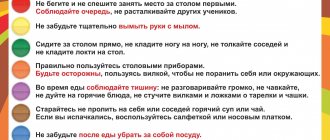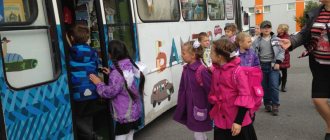Child safety in kindergarten
Our children are our future... This is a well-known truth, especially taking into account the social values of our state. But at the same time, we constantly hear about various emergencies that happen to children in certain educational institutions. Who is responsible for them? How and by whom is the safety of children ensured, for example, within the walls of kindergartens? Let's understand the material.
Who provides security and is responsible?
Kindergarten pupils have the right to protection of life and health during the educational process <*>. The responsibility to create a safe environment lies with the educational institution, i.e. on its employees, under whose control and supervision children are <*>. In kindergarten it is:
- a preschool teacher ( educator ), who is personally responsible for creating a safe environment when organizing the educational process. He must comply with the rules for protecting the life and health of children; established fire safety requirements, etc.; must know the basics of first aid;
- assistant teacher , who must know the rules and regulations for protecting the life and health of students; sanitary and hygienic standards for the maintenance of premises, equipment, inventory; first aid rules; fire safety rules and regulations, etc.
Note In practice, as a rule, for one group of pupils there are two teachers working in shifts and one assistant teacher. That is, direct control and supervision of children is carried out simultaneously by two people . At the same time, the teacher always bears personal responsibility for the children. Along with him, the assistant teacher is also responsible if the children remain only under his control, and at night in kindergartens with children staying around the clock, he bears full responsibility;
- the head of the kindergarten , who is responsible for the results of the activities of the educational institution; for life and health, respect for the rights and freedoms of children during the educational process; takes measures to create safe and favorable learning and upbringing conditions for children; ensures compliance with fire safety rules and regulations, etc.
Note! The following persons do not have the right to work with children: - those with a criminal record - until it is expunged or withdrawn; - those deprived of the right to engage in teaching activities; - those who have ever committed crimes against sexual integrity or sexual freedom or some others <*>; - those who have not passed preliminary preventive drug examination <*>.
Thus, as soon as you brought your child to kindergarten and handed him over to the teacher or his assistant, the kindergarten staff bears responsibility for your child. The child is in their area of responsibility until the moment when he returns under your direct control , i.e. when you are close to the child and can control him (for example, hold his hand).
Note: Situations are possible when a child sees his mother “on the horizon” and runs towards her; or they called him on the phone and said that they would pick him up soon, and the child went to the locker room to get dressed; or he himself decided that it was time to go home and left the group on his own. If something happened to him at this time (fell, hit, got hit by a car), responsibility will be borne by the persons under whose control and supervision the child was or should have been. In all the above situations, these are teachers and their assistants.
How security is ensured
The comprehensive safety of kindergarten students usually includes:
— fire safety measures;
— measures to ensure sanitary and epidemiological well-being;
— measures to ensure the safety of children’s lives and health;
— occupational health and safety measures;
— electrical safety measures;
— civil defense activities (training of administration and personnel);
— anti-terrorism security measures.
Authorized state bodies and organizations are responsible for compliance by the kindergarten administration with safety requirements in each of the listed areas (for example, education departments of district administrations, state fire inspection bodies, state sanitary inspections, internal affairs bodies, etc.). As part of their activities, they issue mandatory rules, instructions, regulations, etc. Compliance with these standards is verified through inspections and other activities. At the same time, in practice, it is quite difficult for parents to make sure that all these norms are actually observed.
However, parents also have other opportunities to influence the safety of children in kindergarten. Some measures and measures to ensure safety are not prescribed anywhere, but can be introduced by the head at the level of a particular kindergarten at the suggestion of parents or on their own initiative. It is desirable that these measures be implemented in a comprehensive manner. The reason for their introduction, as a rule, is various emergencies, news of which spreads quite quickly. Here are some of these measures.
Access mode or “trusted person system”
Only so-called authorized persons can pick up a child from kindergarten. And this is not just a circle of people whom the child has recognized and with whom he is ready to leave, for example, relatives, neighbors or acquaintances. First of all, such persons include the legal representatives of the child , i.e. his parents, adoptive parents, guardians, trustees <*>.
Note: In practice, there are cases when a teacher should check even a legal representative. For example, the child’s parents are divorced and the child permanently lives with his mother, who always picks him up. If the father suddenly comes to pick up the child, the teacher is advised to call the mother and find out if she allows the child to go with him.
Trusted persons, in turn, can entrust other persons, in particular grandparents, adult brothers and sisters, to pick up the child from kindergarten.
Note : In practice, as a rule, such trust is formalized by writing a power of attorney, which is given to the teacher along with a copy of the proxy’s passport and stored on the premises of the kindergarten.
In some kindergartens, a special pass is issued for each authorized person, without which they will not only not be given the child, but will not even be allowed into the territory of the kindergarten.
CCTV
This measure may help:
— to recreate the picture of the emergency that occurred, determine the culprit, and the location of the responsible persons;
— detect children left unattended;
— track the direction of the child’s movement if he left the kindergarten territory on his own;
- expel unauthorized persons from the territory of the kindergarten or identify them by image if they have committed illegal actions, etc.
At the same time, organizing competent video surveillance throughout the kindergarten is an expensive undertaking. Often educational institutions themselves cannot afford such expenses. Typically, parents of kindergarten students or, less commonly, other individuals purchase the necessary equipment as sponsorship. In addition, video cameras and other equipment must not only be installed, but also maintained.
Note: This measure is good if certain conditions are met, in particular: - cameras must always be in working order; - it is possible to view the image on any of the displays included in the system; - there is an employee on an ongoing basis authorized to monitor the image from the cameras (watchman , security guard);— camera recordings are stored on the server for a certain period of time;— it is possible to search for images by date and time of recording, as well as enlarge selected images or their fragments, print individual frames, etc.
Non-free entry and exit
This measure can prevent:
— the presence of unauthorized persons on the territory with unclear intentions;
- the appearance on the territory of the kindergarten of objects and things that can cause harm to the child (syringes, needles, firecrackers, lighters, broken glass, cans, etc.);
- walking dogs that can scare or bite children, etc.
This is implemented by installing locking devices at the entrances (doors, gates, gates) to the kindergarten. They are open only during the arrival and departure of pupils, usually from 7 to 9 and from 16 to 19 hours. In some gardens, entry is made by calling the gate, when a security guard (watchman) opens it remotely.
It also makes sense to install locking devices with a latching mechanism at the entrances to the kindergarten building. Then the door will open from the inside and outside after pressing a button, which is at the height of an adult. In this case, it is possible to prevent children from going outside unaccompanied by adults.
Preventive activities involving children
They are conducted by employees of the Ministry of Emergency Situations and the Department of Internal Affairs in the form of lectures and practical exercises for the benefit of children and adults. During events:
— will tell you about the rules for handling fire and flammable objects;
— will teach rules of behavior on the road and on the street;
— they will explain in an accessible form for children how not to get lost on the street and in the crowd, how to behave with strangers;
— remind adults about the dangers of leaving children unattended, etc.
These events are carried out both as part of our own actions and at the request of kindergarten administrations.
Useful gadgets
In the 21st century it is impossible not to take advantage of high technologies. Modern gadgets not only have entertaining, educational, and service functions, but they can also help in a dangerous situation or prevent this situation from happening.
For example, a smart children's watch with GPS will help:
— track the child’s movements throughout the day;
- make calls to him;
— fence off the area, when a child leaves it a notification will be sent;
- listen to what is happening around the child.
Also, the child himself can call his parents and talk on speakerphone or, by pressing the SOS button, notify about the danger. The undoubted advantage is that the watch is always with the child; it is not as easy to lose as a phone, because it is fixed on the wrist. In addition, the child himself will not be able to turn them off (according to the manufacturer), and some have a special sensor that will notify the parent when the watch is removed. These watches can be used from the age of 3 years.
Note: In dangerous situations, sometimes adults can become confused and not know what to do. Parents and kindergarten workers can be recommended to install the application “Ministry of Emergency Situations of Belarus: Help is Near” . It will help you navigate unusual situations (a child is lost or an adult is lost, a dog has bitten, there is smoke or the smell of gas, etc.). The “First Aid” section is equipped with audio prompts for first aid actions in the most common cases. It is also possible to call the Ministry of Emergency Situations using the “112” button from almost any page of the application.
Children's safety at home
Even in a properly organized home environment, surprises can appear that pose a danger to children. For example, the ability to climb onto a windowsill or go out onto a dangerous balcony. We must try to anticipate the maximum number of dangerous situations and prevent their occurrence. To control them, it is suggested to use the list of “popular” dangerous places at home:
- Sockets, electrical appliances. They should not be accessible.
- The stove in the kitchen is considered a particularly attractive place. The kettle is hot, pots should not be placed close to the edges.
- All sharp corners on furniture must be protected with special pads.
- Bags (children like to put them on their heads), laces, ropes, belts, and scarves are often tried on around their necks.
- All chemicals poured into bottles resembling juice, water (vinegar, detergents).
- Cutting, piercing means. Needles, threads, manicure accessories, buttons, pins.
- Medicines, matches, lighters.
The time to leave children at home alone always comes in every family. This is determined individually and depends on independence and trust in the child. Gradually taming him to be alone must be done, providing the following safety techniques :
- In a visible, accessible place (always in the same place) leave the telephone numbers of: parents (work and personal), (closest relatives who can come quickly). Police, ambulance, neighbors. Children now have their own mobile phones early, and they use them well.
- Check the operation of the gas stove, water, close windows, doors or check safety devices. Leave food for children in cooked form or teach them to use a microwave heating device.
- Teach children to use the peephole and not to open the door at the first signal on the intercom or door. When a stranger appears at the door, never say that you are alone at home (it is also prohibited to do this on the phone), but quickly contact one of your parents’ phones, your neighbors (or call the police).
- Explain to children that they are safe behind a closed door. You are not allowed to go onto the site. We must wait for the departure of the stranger standing outside the door.
- When leaving home in the evening, you must leave the lights on in the rooms.
- If a child is allowed to go for a walk (age and training in the rules of walking allow it), then the keys to the apartment should not be placed on the neck or belt. To do this, you need to provide a convenient internal pocket with a clasp. Before a walk, a child should be taught to follow the following rule: leave information about where, with whom, for how long he is going, and when he will return home. Indicate a way to quickly contact him.
Information security for children
Children learn practical skills for safe living during their formative years in different ways. Advice from parents such as “don’t go”, “don’t talk”, “don’t take”, etc. is not immediately followed correctly. The role of the particle “not” in the conceptual apparatus is not formed immediately. Often the opposite action follows: “do not open, is replaced by the meaning - open”, etc.
Psychologists advise presenting safety information in other terms with detailed clarification. For example, instead of the prohibition “don’t walk,” it would be more correct to say “walk in the yard, not far from the house.” Instead of the expression “don’t open”, say “don’t open the door quickly, without looking through the peephole, and to strangers.” It is better to submit prohibitory actions in a permitting format with explanations of what needs to be done.
Information security rules can be combined in the following areas:
1. Knowledge of complete information about the child’s friends, their places of residence, parents’ addresses (and do not be afraid to leave your coordinates). Places for games in your own and neighboring yard.
2. Explanation of life-threatening situations located in the gaming area. For example, rules of conduct on open water, correct activities on the water. To do this, the first skills must be explained while bathing in the bath (dive, hold your breath, do not close your eyes under water). The main thing is to overcome the first fear when children “lose the bottom” under their feet. Talk about the dangers of frozen bodies of water and walking on thin ice.
3.Training of traffic rules for pedestrians. At the same time, it is important to remember that children tend to imitate, and if parents themselves violate the requirements of crossing a green light or a zebra crossing, then the children will definitely try to do the same. The results may be severe. The optimal route must be mastered together, many times, fulfilling all the requirements, despite the behavior of those walking nearby.
It must be taken into account that a small child does not always hear the warning signals of a car. He fixes attention on several objects simultaneously. A child's emotions and temperament can be caused by surprise at a new car model or any other object. Joy and curiosity distract him from caution and elements of safety. At the same time, when walking with a teenager, you need to give him a certain amount of independence without causing excessive moralizing, which causes a negative reaction.
4. In addition to instructions, parents should always remember to behave tactfully with children, especially when explaining safety information. This refers to talking about sexual problems that arise in unfavorable situations. From early childhood, it is recommended to carefully explain to children which places should not be allowed to be touched by strangers.
Why can’t you visit a public toilet alone, walk in vacant lots, go into basements, abandoned buildings. Unfortunately, sexual crime in the present world has increased greatly and children need to know about it. Children should not take candy or other sweets from strangers, approach unknown cars, or respond to offers like “I’ll take you to mommy.”
5. Particular attention should be paid to the issue of communication with animals on the street. It is best if you have your own dog or cat at home, and parents regularly talk about different breeds of dogs, their character, and rules of behavior when meeting.
6.An innovation in the modern world is communication on the Internet. This type of progress (useful and interesting) cannot be stopped. But it is fraught with many dangers for an unformed child’s worldview. To avoid very unpleasant situations, it is recommended to follow these rules when purchasing a computer for the first time:
- stipulate a list of rules for visiting the Internet. The computer must be within sight of parents. Have anti-virus programs, settings, filters used for safe travel on the Internet. Set the “parental control” mode with a list of prohibited sites, games, and programs. Negotiate working hours online;
- constantly talk with children about their friends on the Internet. Explain why you can't meet them (they're often not who they say they are online). Learn to use a pseudonym (during online games) without giving away personal information. Do not open files or messages from unfamiliar recipients;
- Problems of gambling, sites with pornography, and violence should be discussed with teenagers. You can’t simply prohibit doing this (the forbidden fruit is sweet). Only trusting, friendly relationships help to cope with unwanted information and develop the right attitude towards all information from the Internet. And then you don’t have to listen to the famous expression “the Internet is a garbage dump”, but get a lot of interesting knowledge without going to the library.







